The worst game ever? Retrospective of Custer’s Revenge
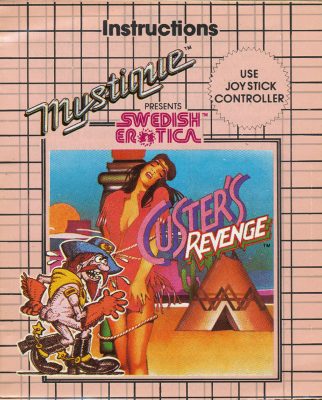 “This game is so bad it makes Superman 64 look like Doom.” — anonymous game reviewer
“This game is so bad it makes Superman 64 look like Doom.” — anonymous game reviewer
By Patrick S. Baker
Okay, boys and girls, please have a 55-gallon drum of hand sanitizer ready for this one. Today gentle readers I recount the story of not only one of the worst video games of all time but also one of the foulest and most atrocious video games of all time. And NO, I’m not exaggerating in any way about what a disgusting piece of work this game is.
Custer’s Revenge, also known as Mystique Presents Swedish Erotica: Custer’s Revenge was one of three ‘adult’ video games released November 1982 in a package of video games called Mystique Presents Swedish Erotica. The other two games in the set were Beat ‘Em & Eat ‘Em and Bachelor Party.
Many sources erroneously report that the games were produced by a game company named Mystique, but in fact is no game company named Mystique. Mystique was the brand name for the line of adult games produced by American Multiple Industries (AMI).
In 1981, freelance marketing consultant Stuart Kerten’s discovered that one in three Penthouse Magazine subscribers also owned an Atari 2600 gaming system. Seeing what he thought was a vast untapped market for adult games, Kerten, along with Joel Martin, founded AMI in July 1982 to fill that niche.
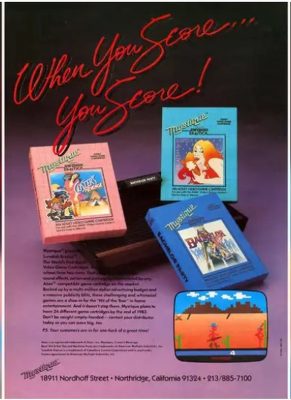 The pair quickly put together a multi-national team of people in Los Angeles, Hong Kong, and Silicon Valley to develop the games. Kerten then reached out to a number of adult film companies about a strategic partnership. Ultimately, Kerten cut a deal with Caballero Control Corporation (CCC), best known for its long-running Swedish Erotica video series. In the deal, inked in August 1982, CCC licensed to AMI the Swedish Erotica brand name in exchange for royalties on the games.
The pair quickly put together a multi-national team of people in Los Angeles, Hong Kong, and Silicon Valley to develop the games. Kerten then reached out to a number of adult film companies about a strategic partnership. Ultimately, Kerten cut a deal with Caballero Control Corporation (CCC), best known for its long-running Swedish Erotica video series. In the deal, inked in August 1982, CCC licensed to AMI the Swedish Erotica brand name in exchange for royalties on the games.
Kerten gave his game-developing team about two months to produce some games. By the Fall of 1982, Kerten was already giving interviews and placing ads in Billboard Magazine regarding AMI’s Mystique/Swedish Erotica games. At about the same time, in an interview printed in the L.A. Times, Kesten said the games were not pornographic but were more like dirty jokes. He went on to add that they were designed not to “arouse” but to merely “entertain.’
In Bachelor Party, a near copy of Atari’s Breakout, the player bounced a nude man at a wall of nude women, instead of a ball against a brick wall. Beat ‘Em And Eat ‘Em was a rip-off of Activision’s Ka-Boom! In Ka-Boom!, the player had to catch bombs before they hit the ground. In the Mystique game, a man is firing his semen into the air and the player must catch it in a nude woman’s mouth.
However, the stunning vulgarity of these games was nothing compared to that of the third game in the pack: Custer’s Revenge. In a Frogger-type game, the player maneuvers a very aroused George Armstrong Custer dressed in nothing but boots, hat, and bandana across a field of cacti while avoiding flights of arrows to reach a Native American woman, named Revenge, tied to a post. There is some dispute as to what happens when Custer reaches Revenge. He either rapes the woman or engages in consensual sex with her.
Either way, it is offensive on lots of different levels.
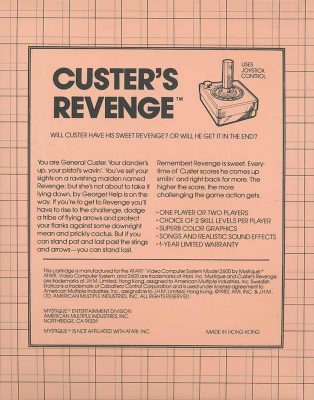 The game’s reception was not good, but Custer’s Revenge was the target of protests and legal action. At a press event in October 1982 to unveil the games over a video game some 300 protestors from the American Indian community, the National Organization for Women (NOW), and Women Against Pornography (WAP) showed up outside the event to march and carry signs, in the largest demonstration ever against a video game.
The game’s reception was not good, but Custer’s Revenge was the target of protests and legal action. At a press event in October 1982 to unveil the games over a video game some 300 protestors from the American Indian community, the National Organization for Women (NOW), and Women Against Pornography (WAP) showed up outside the event to march and carry signs, in the largest demonstration ever against a video game.
The Suffolk County, New York, the legislature voted to ban all “X-rated” games within the county. While this action was prompted by Custer’s Revenge, it also included other, non-Mystique games. AMI sued Suffolk Country for $11 million dollars in damages on First Amendment grounds, and to prevent enforcement of the ban.
Across the country, other jurisdictions also acted. The Los Angeles County Board of Supervisors voted to ban all the Mystique games. The Oklahoma City Council unanimously passed a resolution condemning Custer’s Revenge as “distasteful” and “not in the best interests of the community” but did not ban it outright.
Even Atari jumped on the lawsuit bandwagon and sued AMI for copyright infringement, as AMI had put the Atari logo on the game cartridges without permission and Atari did not want to have any association with the AMI games.
 All of this begs the question of what the quality of Custer’s Revenge as a game was, setting aside its offensive subject matter. There seems to be few contemporary reviews of the game, in fact, most mainstream video game publications at the time were reluctant to even describe the game much less offer an opinion on it. One contemporary review stated that Custer’s Revenge’s “gameplay is as boring as boring can be” and found the other Mystique games “tedious”. Also, one aggregator site stated that the game was badly received due to repetitive gameplay and poor graphics, with the two main characters’ appearance being compared to “Legos” and “cardboard boxes.”
All of this begs the question of what the quality of Custer’s Revenge as a game was, setting aside its offensive subject matter. There seems to be few contemporary reviews of the game, in fact, most mainstream video game publications at the time were reluctant to even describe the game much less offer an opinion on it. One contemporary review stated that Custer’s Revenge’s “gameplay is as boring as boring can be” and found the other Mystique games “tedious”. Also, one aggregator site stated that the game was badly received due to repetitive gameplay and poor graphics, with the two main characters’ appearance being compared to “Legos” and “cardboard boxes.”
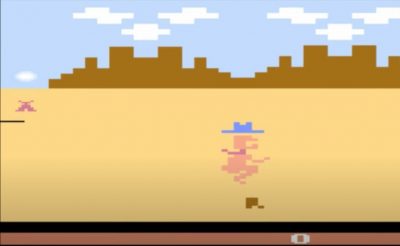 Different sources report different sales figures for Custer’s Revenge. One reports 75,000 units, another 80,000 units and a third some 200,000 units sold. AMI claimed to have made some $13 million dollars on a $1.2 million dollar investment. This is despite the Mystique games being priced at $49.99 a piece, when typically, new games cost about $30 a copy.
Different sources report different sales figures for Custer’s Revenge. One reports 75,000 units, another 80,000 units and a third some 200,000 units sold. AMI claimed to have made some $13 million dollars on a $1.2 million dollar investment. This is despite the Mystique games being priced at $49.99 a piece, when typically, new games cost about $30 a copy.
In a twist, in January 1983, AMI discontinued producing Custer’s Revenge, passed the production and marketing of the other two Mystique games to a company called GameSource and left the video game industry. Kerten stated in an interview that: “The publicity (over Custer’s Revenge) was just so negative…” the company could not continue to operate in the video game industry.
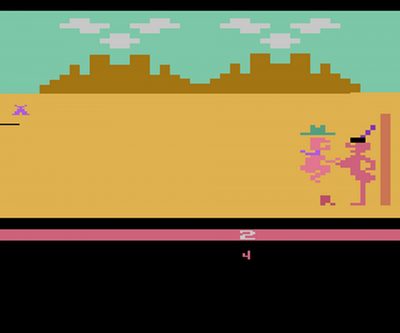
Needless to add, Custer’s Revenge is on list after list of the worst video games of all time. For example, it is on the 2006 worst games lists from PC World and GameTrailers and the 2017 list on Electronic Gaming Monthly. The game is also called the Most Shameful Game of all time on Gamespy.
Patrick S. Baker is a former US Army Field Artillery officer and retired Department of Defense employee. He has degrees in History, Political Science and Education. He has been writing history, game reviews and science-fiction professionally since 2013. Some of his other work can found at Sirius Science Fiction, Sci-Phi Journal, Armchair General and Historynet.com
Sources:
Billboard Magazine (11 December 1982) “‘Custer’ Game Is Subject of Two Lawsuits”.
Electronic Gaming Monthly (23 May 2017) “EGM’s Crapstravaganza: The 20 Worst Games of All Time”.
Eureka California Times-Standard (17 November 1982) “L.A. Supervisors vote to ban video sex games”.
GameSpy.com. (16 April 2009) “Top Ten Shameful Games”.
GameTrailers.com 17 November 2006) “Top 10 Best and Worst Games of All Time”.
Hollywood Reporter (5 August 1982) Adult Video Games to be Marketed
InfoWorld (8 November 1982). “Video-pornography games cause protest”
Kotaku, (6 September 2021) “Porno Hustlers Of The Atari Age”
Oklahoman, The (27 October 1982). “Council Slaps “Custer’s Revenge’ Game as “Distasteful'”.
Oklahoman, The (15 January 1983) Firm Ends Adult Video Game Production
PCWorld. (23 October 2006). “The 10 Worst Games of All Time”.
Videogaming and Computer Gaming Illustrated (October, 1983) Are Adults Ruining It For The Rest Of Us?
Videogamegeek.com “Custer’s Revenge”
Yonkers New York Herald Statesman, The. (10 November 1982) “X-rate video loses vote”.
